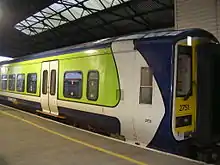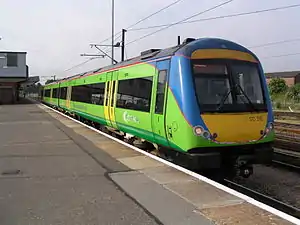Diesel multiple unit
A diesel multiple unit or DMU is a multiple-unit train powered by on-board diesel engines. A DMU requires no separate locomotive, as the engines are incorporated into one or more of the carriages. Diesel-powered single-unit railcars are also generally classed as DMUs. Diesel-powered units may be further classified by their transmission type: diesel–mechanical DMMU, diesel–hydraulic DHMU, or diesel–electric DEMU.

| Multiple unit trains |
|---|
| Subtypes |
| Technology |
| By country |
|
Design
The diesel engine may be located above the frame in an engine bay or under the floor. Driving controls can be at both ends, on one end, or in a separate car.
Types by transmission
DMUs are usually classified by the method of transmitting motive power to their wheels.
Diesel–mechanical
In a diesel–mechanical multiple unit (DMMU), the rotating energy of the engine is transmitted via a gearbox and driveshaft directly to the wheels of the train, like a car. The transmissions can be shifted manually by the driver, as in the great majority of first-generation British Rail DMUs, but in most applications, gears are changed automatically.
Diesel–hydraulic
In a diesel–hydraulic multiple unit (DHMU), a hydraulic torque converter, a type of fluid coupling, acts as the transmission medium for the motive power of the diesel engine to turn the wheels. Some units feature a hybrid mix of hydraulic and mechanical transmissions, usually reverting to the latter at higher operating speeds as this decreases engine RPM and noise.
Diesel–electric
In a diesel–electric multiple unit (DEMU), a diesel engine drives an electrical generator or an alternator which produces electrical energy. The generated current is then fed to electric traction motors on the wheels or bogies in the same way as a conventional diesel–electric locomotive.[1]
On some DEMUs, such as the Bombardier Voyager family, each car is entirely self-contained and has its own engine, generator and electric motors.[1] In other designs, such as the British Rail Class 207 or the Stadler GTW and Stadler Flirt DMU,[2] some cars within the consist may be entirely unpowered or only feature electric motors, obtaining electric current from other cars in the consist which have a generator and engine.
With diesel–electric transmission, some DMU can be no other than an EMU without pantograph, which "is substituted" by one or more on-board diesel generators; this kind of DEMU can be potentially upgraded to electro-diesel multiple unit EDMU, becoming a bi-mode multiple units train (BMU), just adding one or two pantographs (with opportune converters, if necessary) and related modifications on the electric system.
Advantages and disadvantages
A train composed of DMU cars scales well, as it allows extra passenger capacity to be added at the same time as motive power. It also permits passenger capacity to be matched to demand, and for trains to be split and joined en route. It is not necessary to match the power available to the size and weight of the train, as each unit is capable of moving itself. As units are added, the power available to move the train increases by the necessary amount. DMUs may have better acceleration capabilities, with more power-driven axles, making them more suitable for routes with frequent closely spaced stops, as compared with conventional locomotive and unpowered carriage setups.
Distribution of the propulsion among the cars also results in a system that is less vulnerable to single-point-of-failure outages. Many classes of DMU are capable of operating with faulty units still in the consist. Because of the self-contained nature of diesel engines, there is no need to run overhead electric lines or electrified track, which can result in lower system construction costs.
Such advantages must be weighed against the underfloor noise and vibration that may be an issue with this type of train.
Generally diesel traction has several downsides compared to electric traction, namely higher fuel costs, more noise and exhaust as well as worse acceleration and top speed performance. The power to weight ratio also tends to be worse.
DMUs have further disadvantages compared to diesel locomotives in that they cannot be swapped out when approaching or passing onto an electrified line, necessitating either passengers to change trains or Diesel operation on electrified lines. Similarly the lost investment once electrification reduces the demand for diesel rolling stock is higher than with locomotive hauled trains where only the locomotive has to be replaced. Finally, incremental maintenance costs for DMUs are significantly higher than with electric (EMUs), because of the added fueling, lubrication, replacement and maintenance of engine parts and systems in every car.
Around the world
Belgium
NMBS/SNCB uses its NMBS/SNCB Class 41 DMUs on the few remaining unelectrified lines. As electrification progresses, the DMUs become less and less important.
Croatia
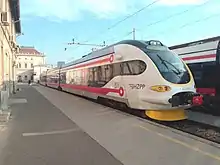
Diesel multiple units cover large number of passenger lines in Croatia which are operated by the national operator Croatian Railways. On Croatian Railways, DMUs have important role since they cover local, regional and distant lines all across the country. The country's two largest towns, Zagreb and Split, are connected with an inter-city service that is provided by DMU tilting trains "RegioSwinger" (Croatian series 7123) since 2004. Those trains may also cover other lines in the country depending on need and availability.
Luxury DMU series 7021, built in France, started to operate for Yugoslav Railways in 1972 and after 1991 stil remained in service of Croatian Railways until 2005. Units 7121 and 7122 (which came as a replacement for 7221 units), together with the newest series 7022 and 7023 built in 2010s Croatia, cover many of the country's local and regional services on unelectrified or partly electrified lines.
Czech Republic
Diesel multiple units also cover large number of passenger lines in the Czech Republic which are operated by the national operator Czech Railways. They have important role since they cover local, regional and distant lines all across the country. Those trains may also cover other lines in the country depending on need and availability too.
Plus, the DMUs were manufactured for foreign carriers. The tables of cars and units are divided into vehicles operated until 1987, when the ČSD used the series designations proposed by Vojtěch Kryšpín, and vehicles created after this date, which no longer have Kryšpín's designations (with some exceptions). In addition, these new cars are the new vehicles are already different in both countries.
Estonia
Elron has since 2015 a Stadler Flirt fleet, with 20 trains DEMU version.
Ireland
In the Republic of Ireland the Córas Iompair Éireann (CIÉ), which controlled the republic's railways between 1945 and 1986, introduced DMUs in the mid-1950s and they were the first diesel trains on many main lines.[3]
Romania
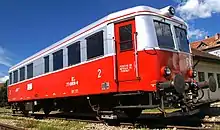
DMUs are used mostly on shorter and less frequently travelled routes in remote and often poorer areas like Banat and Bukovina. The national railway company CFR uses Malaxa class 77 and 78 DMUs locally built between the 1920s and 50s and refurbished in the 70s. It also uses a smaller number of other newer DMUs. Main DMU in use is the Class 96 Siemens Desiro aka Săgeata Albastră (Blue Arrow).
Slovakia
%252C_SK-ZSSK_813_044-5_(M%C3%A1ria)%252C_SzG3-2.jpg.webp)
In the present, several types of DMUs operate in Slovakia. Currently (2020) is the most common type in Slovakia is a Class 812 ZSSK based on the ČD Class 810. These are used almost exclusively for hauling passenger trains on non-electrified regional lines and these trains often excel in low travel speeds. In the past, however, in Slovakia there were a number of express trains driven by motor cars (these were called MR - motor express train), which often overcame heavier trains driven by steam locomotives at cruising speed, and classic sets. A typical example can be, for example, the Slovenská strela motor express train led on the Bratislava-Prague route by a motor car of the same name, or the Tatran express from Bratislava to Košice. Representatives of high-speed motor wagons were, for example, motor wagons of the M262 or M286 series, which, however, lost their application in high-speed wagons due to the gradual electrification of main lines and were, like the current wagons currently used for passenger trains.
United Kingdom
The first significant use of DMUs in the United Kingdom was by the Great Western Railway, which introduced its small but successful series of diesel–mechanical GWR railcars in 1934. The London & North Eastern Railway[4] and London, Midland & Scottish Railway also experimented with DMUs in the 1930s, the LMS both on its own system, and on that of its Northern Irish subsidiary, but development was curtailed by World War II.
After nationalisation, British Railways (BR) revived the concept in the early 1950s. At that time there was an urgent need to move away from expensive steam traction which led to many experimental designs using diesel propulsion and multiple units. The early DMUs proved successful, and under BR's 1955 Modernisation Plan the building of a large fleet was authorised. These BR "First Generation" DMUs were built between 1956 and 1963.
BR required that contracts for the design and manufacture of new locomotives and rolling stock be split between numerous private firms as well as BR's own workshops, while different BR Regions laid down different specifications. The result was a multitude of different types, one of which was:
- 'Intercity' units, which were more substantially constructed, and shared many features with contemporary hauled coaching stock. They were built for express services on important secondary routes on the Scottish, North Eastern and Western regions.
In 1960, British Railways introduced its Blue Pullman high-speed DEMUs.[5] These were few in number and relatively short-lived,[5] but they paved the way for the very successful InterCity 125 or High Speed Train (HST) units, which were built between 1975 and 1982 to take over most principal express services on non-electrified routes.[6][7] These 125 mph (201 km/h) trains run with a streamlined power car at each end and (typically) 7 to 9 intermediate trailer cars.[8][9] Although originally classified as DEMUs, the trailer cars are very similar to loco-hauled stock, and the power cars were later reclassified as locomotives under Class 43.[8][9] They remain in widespread use.[8][9]
By the early 1980s, many of the surviving First Generation units were reaching the end of their design life, leading to spiralling maintenance costs, poor reliability and a poor public image for the railway. A stopgap solution was to convert some services back to locomotive haulage, as spare locomotives and hauled coaching stock were available, but this also increased operating costs. Commencing in the mid '80s, British Rail embarked upon its so called "Sprinterisation" programme, to replace most of the first generation DMUs and many locomotive-hauled trains with three new families of DMU:
- Class 140–144 Pacer railbuses, ultra-low-cost diesel–mechanical units utilising 4-wheeled chassis and lightweight bus bodywork, designed for provincial branch line and stopping services.
- Sprinter a family of diesel–hydraulic DMUs. These fall into three sub-groups; Class 150 Sprinters (for branch line/commuter service), Class 153 / 155 / 156 Super Sprinters (for longer cross country services), and Class 158 / 159 Express units (for secondary express services);
- Networker diesel–hydraulic units, of Class 165 Network Turbo (standard commuter version) and Class 166 Network Express (for longer distance commuter services). These took over the remaining non-electric commuter services into London.
Following the impact of the privatisation of British Rail in the late 1990s, several other diesel–hydraulic DMU families have been introduced:
- Class 168 Clubman and Class 170/171/172 Bombardier Turbostars, a development of the earlier Networkers. These are built by Adtranz and later Bombardier at Derby Litchurch Lane Works and are the most numerous and widespread of the post-privatisation designs. Purchased by Anglia Railways, Central Trains, Chiltern Railways, London Midland, London Overground Rail Operations, Midland Mainline and ScotRail.
- Class 175 Alstom Coradias were designed by Alstom as a rival to the 170 Turbostar, but bought only by First North Western
- Class 180 Adelantes were an Alstom design for express services built only for First Great Western
- Class 185 Siemens Desiros, built by Siemens introduced in 2006 by First TransPennine Express
- Class 195/196 CAF Civitys, being built by CAF for Arriva Rail North and West Midlands Trains
- Class 220/221/222 Voyagers/Meridians built by Bombardier in Bruges for Hull Trains, Midland Mainline and Virgin CrossCountry
In 2018 the first bi and tri-mode electro-diesel multiple units were introduced:
- Class 800/802s are being built by Hitachi for Great Western Railway, Hull Trains, London North Eastern Railway and TransPennine Express[10]
- Class 755 Stadler Flirts are to be operated by Abellio Greater Anglia[11]
- Class 769s are being converted by Brush Traction from Class 319s for Arriva Rail North, Great Western Railway and KeolisAmey Wales[12]
- Class 230s are being converted by Vivarail from London Underground D78 Stock[13] for West Midland Trains[14] and Transport for Wales[15].
Canada

Canada generally follows similar buffer strength requirements to the US,[16] but new services are evaluated on a case-by-case basis. As a result, several types of lightweight DMUs have been used:
- The O-Train Trillium Line in Ottawa, Ontario uses European-standard Alstom Coradia LINT (previously Bombardier Talent) DMUs on conventional railway tracks under a specific safety agreement with Transport Canada.
- Via Rail operates Budd Rail Diesel Cars on its Sudbury – White River train.
- Réseau Charlevoix (Le Massif) operates a shuttle in the Charlevoix region, Québec.
- Canadian National operates the small custom-built Kaoham Shuttle between Lillooet, and D'Arcy via Seton Portage, 213 km (132 mi) northeast of Vancouver, in a partnership with the Seton Lake Indian Band.[17]
- Union Pearson Express uses Nippon Sharyo DMU trains for express service between Union Station and Pearson Airport.
Costa Rica

Costa Rica has purchased several Apolo 2400 series DMU railcars from the former narrow gauge operator in Spain, which are run in commuter service.[18]
United States

A type of diesel multiple units in the U.S. was the Budd Rail Diesel Car (RDC). The RDC was a single passenger car with two diesel engines and two sets of controls.
In the United States only FRA-compliant DMU systems are permitted on freight rail corridors. This is due to the Federal Railway Administration setting higher coupling strength requirements than European regulators, effectively prohibiting the use of lighter weight European-style inter-city rail DMUs on U.S. main line railways without timesharing with freight operations or special waivers from the FRA. This has greatly restricted the development of DMUs within the U.S. as no other country requires the much heavier FRA compliant vehicles, and no export market for them exists.[19]
Operations using FRA-compliant vehicles:
- The South Florida Regional Transportation Authority has used a Colorado Railcar bi-Level DMU and Coach consist since October 2006 as a technology demonstrator on the 87-mile long Tri-Rail commuter rail line between Miami and West Palm Beach, Florida. In early 2007, three more bi-level DMUs and an additional bi-level non-powered coach were acquired.
- Since February 2009, TriMet is using FRA-compliant Colorado Railcar DMUs for its rush-hour WES Commuter Rail service, a suburb-to-suburb line between Beaverton and Wilsonville, Oregon. The opening of the line was delayed from fall 2008 to early 2009 due to delays in getting the vehicles. TriMet also has four refurbished former Alaska RR and Trinity Railway Express RDCs as backup trainsets for when one or more Colorado Railcar DMUs is out of service.
- Also in Oregon, former BC Rail RDCs were used on the Lewis and Clark Explorer excursion train from Portland to Astoria.[20]
- Sonoma–Marin Area Rail Transit, also referred to as SMART, operates Nippon Sharyo DMUs (the same as those in Toronto) on its route between San Rafael and Santa Rosa, California. Service commenced in 2017.
Operations using non FRA-compliant vehicles:
- Capital Metro uses Stadler GTW cars to operate Capital MetroRail, a commuter rail line serving the Greater Austin, Texas area.
- In Denton County, Texas, DCTA also uses Stadler GTW cars to operate its A-train service. DCTA has secured from the FRA the first-ever alternative vehicle technology waiver to use these cars on active freight corridors.[21]
- TEXRail in Tarrant County, Texas is a commuter rail line operated by Trinity Metro which uses Stadler FLIRT DMUs. The vehicles are FRA Alternate Compliant.[22] The line has 9 stops with termini at DFW Airport and T&P Station.[23]
- NJ Transit operates the River Line from Camden, NJ to Trenton, NJ, every 15 minutes during peak hours and every 30 minutes at other times. It uses modified Stadler GTW trains of one or two cars. The line is classified as light rail because it utilizes imported European made DMUs that do not meet FRA crash guidelines. The cars may not operate with the freight rail service that shares the line, so evening operating hours are restricted to Saturday nights. This line currently carries over 7,500 passengers on a typical weekday, exceeding expectations.
- NCTD operates the Sprinter line using Desiro Classic DMUs built by Siemens AG. Opened March, 2008, The line operates every half-hour daily, except limitations in the morning and at night on Saturday, Sunday and on holidays. The line runs from Oceanside, CA, where transfer is possible with Coaster commuter rail service to San Diego, to Escondido, CA. Like the NJT River Line, it is classified as light rail due to the use of European made DMUs, but does not run at a more typical light rail frequency.
- The eBART expansion of the Bay Area Rapid Transit System implements Stadler GTW diesel multiple unit train service from Pittsburg/Bay Point station east along the Highway 4 corridor to the town of Antioch. Future expansions in this direction could also connect the eBART service to Oakley, Brentwood, Byron, and beyond to Tracy and Stockton. The DMU system was chosen as a less-expensive alternative to the existing third-rail BART design.[24] Service began on 25 May 2018.[25]
Proposed operations:
- The Los Angeles County Metropolitan Transportation Authority approved an allocation of $250,000 for a feasibility study of DMUs for "future transportation options for the region" on 5 July 2006 (Ara Najarian, Metro Board Member).[26]
- Chicago's commuter rail line, Metra, is studying the use of DMUs on its newly proposed lines (STAR line, SES). They claim these DMUs will have better acceleration, be more fuel efficient, and seat more customers than the current diesel locomotive and double decker rail cars that are currently in use.[27]
- Seattle area – The Central Puget Sound's regional transit agency Sound Transit, along with the Puget Sound Regional Council evaluated the feasibility of both DMU and diesel locomotive technology for operation in the Eastside BNSF Corridor in response to a state legislative request. The Eastside BNSF corridor runs from the City of Snohomish in the north to Renton in the south of the metro area. Sound Transit has no plans to operate passenger rail service in the eastside BNSF corridor, but has committed limited funds to provide capital improvements in the event another public or private operator proposes to operate the service.[28]
- Anchorage Mat-Su area – As part of a joint U.S. Forest Service (USFS) and ARRC Chugach Forest Whistle Stop project, a self-propelled rail car was purchased and delivered spring 2009. The diesel multiple unit (DMU) may be available for flexible demonstration service during winter months.[29]
- The Long Island Rail Road, the busiest commuter railroad in the United States, is exploring the possibility of operating DMUs on some of its lesser traveled routes in non-electrified territory (on the Montauk, Greenport, Port Jefferson, and Oyster Bay branches), where operation of its current fleet of C3 bilevel railcars pulled by DE30AC/DM30AC locomotives is uneconomical and inefficient.
- Arrow will utilize Stadler FLIRT trainsets along its service route in Redlands, California.
- A proposal to use DMUs on Boston's Fairmount Line was initially approved, but was canceled in 2016.[30]
Australia

DMUs were first introduced to Australia in the late mid-20th century for use on quiet branch lines that could not justify a locomotive hauled service. Today, DMUs are widely used throughout Australia's southern states:
- Adelaide Metro use 3000 class DMUs on their suburban network.
- NSW TrainLink use Xplorer DMUs on services from Sydney to Canberra (ACT), Griffith, Broken Hill, Armidale and Moree. Endeavour DMUs are used on services to Bathurst, Moss Vale and Goulburn on the Southern Highlands line, Kiama to Bomaderry and on the Hunter line. Hunter DMUs are also used on the Hunter line.
- Victoria's V/Line uses Sprinter and V/Locity DMUs on all medium distance services.
- Western Australia's Transwa operates the Prospector, AvonLink and Australind on medium and long distance country services.
In Queensland, heritage DMUs are used on the Savannahlander and Gulflander tourist trains.
Bangladesh
Chinese manufactured (CNR Tangshan) DEMU was introduced in Bangladesh from 25 May 2013. DEMU is the country's first-ever commuter train service starting its journey on the Chittagong–Fouzdarhat line. These DEMUs also operate on the Chittagong Circular Railway and on the Bangladesh Railway's service between Dhaka and Narayanganj.[31]

India
DMUs (DEMUs) are widely used in India. DEMUs in India are used in both the 8 coach format and the 4 coach format. These trains replaced many (up to 10 car) trains with a WDM-2 or WDM-3A locomotive in the middle. These old trains had the loco controls duplicated in the Driving Trailer coach and all the actuation information reaching the locomotive through thin communication lines. This was called 'push-pull train'. The longest running such push-pull service operated between Diva - Bhiwandi Road and Vasai Road and was recently converted into an MEMU train service in 2018.
India's first and largest DMU shed at Jalandhar, Punjab, holds more than 90 units placed in service all over Punjab. First generation DMU: Rated power was 700 HP and had 3 or 6 coaches, made first by ICF. Transmission was Voith-hydraulic. Max speed 100 km/h.


Second generation DMU: Rated power is 1400 HP and have 8 coaches. Max speed is 105 km/h. Transmission is DC electric. Made at HCF and RCF.
Third generation DMU: Rated power is 1600 HP and have 10 coaches. Max speed is 110 km/h. Transmission is AC electric. Made at ICF.
Indonesia


State-owned company PT.INKA builds several type of DMU, some of which operate in urban and suburban areas:
- Kualanamu Airport Rail Link - -Woojin DMU
- Minangkabau Airport Rail Link
- Adisumarmo Airport Rail Link
- Kedungsepur
- Sri Lelawangsa
- Prambanan Ekspress
- Way Umpu
- Kertalaya Railbus
- Bathara Kresna Railbus
Japan

In Japan, where gasoline-driven railbuses (on small private lines) and railmotors (Kihani 5000 of the national railways) had been built since the 1920s, the first two streamlined DMUs came in service in 1937, class Kiha 43000 (キハ43000系).[32]
The service of several hundreds (in sum even thousands) of diesel railcars and DMUs started in 1950s following the improvement of fuel supply that was critical during World War II.[33]
Malaysia
The Keretapi Tanah Melayu (KTM) has a total of 13 DMU class 61 ordered from CRRC for the West Coast Line and are assembled locally at CRRCs Batu Gajah factory from 2016 to 2020. The first scheduled service is expected from 1 September along the Gemas-Johor Bahru route, replacing old non-automotive stock.[34]
Philippines
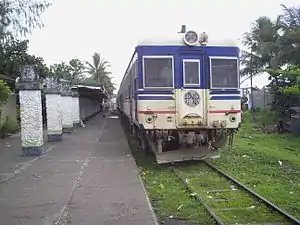

The Southrail or the South Main Line of the Philippine National Railways which travels South of the Luzon island is one of the oldest rail lines in Asia and in the world.[35] The Southrail of Philippine National Railways uses Hyundai Rotem DMUs together with second-hand DMUs from East Japan Railway Company or JR East and Kanto Railway. These are Kiha 52, Kiha 59 which is also known as the "Kogane" and Kiha 350. Trains such as the Hyundai Rotem DMUs Kiha 350 and Kiha 52 are often used for Metro Commuter Line services, while Kiha 59 is mostly used for Bicol interprovincial services and sometimes also for the Metro Commuter services.
South Korea

Korail operates many DMUs. The DHC (Diesel Hydraulic Car), which made its debut for the 1988 Seoul Olympics, can reach speeds up to 170 km/h (106 mph) and serves Saemaul-ho trains.
Sri Lanka
DMUs were first introduced to Sri Lanka in 1940. The aim of this was connecting minor railway stations and stops on the main line where most express trains don't have a halt.[36]
Taiwan
The DMUs are now usually used on the Taiwan Railway Administration Hualien–Taitung Line, North-Link Line, South-Link Line. DMUs in Taiwan are classified as Class DR.
- Class DR2700 – built by Tokyu Car Corporation in 1966; was the fastest train on the West Coast line
- Class DR2800 – built by Tokyu Car Corporation in 1982 and 1984
- Class DR2900
- Class DR3000
- Class DR3100
Manufacturers
DMU manufacturers include:
- Alstom
- AnsaldoBreda, Italy
- Bombardier Transportation of Montreal, Canada
- BHEL, India
- BEML, India
- British Railways, United Kingdom (1950s–1962)
- British Rail Engineering Limited, United Kingdom (1962-1980s)
- Budd Company of United States
- CAF
- Colorado Railcar, US (Rader Railcar 1988–1997, Colorado Railcar 1997–2008, US Railcar[37] 2009– )
- DMZ, Russia
- EIKON International
- Ganz-MÁVAG, Hungary
- Hyundai Rotem of Seoul, South Korea
- INKA, Indonesia
- Integral Coach Factory, Chennai, India
- Luganskteplovoz, Ukraine
- Materfer, Argentina
- Metrovagonmash, Russia
- Niigata Transys of Tokyo, Japan
- Nippon Sharyo/Sumitomo, Japan
- PESA SA
- RVR, Latvia
- Siemens Mobility DMU
- Srida, China
- Stadler Rail of Bussnang, Switzerland
- Torzhoksky car-building factory, Russia
- TÜVASAŞ of Adapazari, Turkey
See also
| Wikimedia Commons has media related to Diesel multiple units, motor coaches and railcars. |
References
- "Cutting noise and smoothing the ride". Railway Gazette. 1 August 2000. Archived from the original on 4 June 2012. Retrieved 20 January 2011.
In the Voyager application, every car has a Cummins underfloor engine and alternator supplying power to a pair of body-mounted traction motors. Each drives one inner axle through a cardan shaft and axle-mounted final drive gearbox.
- Stadler Firt DMU/DEMU example: Elron Elektriraudtee Classes 2200, 2300 and 2400, TEXRail Stadler FLIRT
- Holland, Julian (January 2013). An A-Z of Famous Express Trains: An Illustrated Trip Down Memory Lane. ISBN 9781446302958.
- "LNER Encyclopedia: The LNER Armstrong-Whitworth Diesel–Electric Railcars". Retrieved 19 June 2016.
- Heaps, Chris (1988). "End of the Blue Pullmans". BR Diary: 1968–1977. London: Ian Allan. pp. 66–67. ISBN 978-0-7110-1611-8.
- "1976: New train speeds into service". BBC News Online. London. 4 October 1976. Retrieved 15 February 2011.
- "New opportunities for the railways: the privatisation of British Rail" (PDF). Railway Archive. p. 8. Retrieved 15 February 2011.
- "Class 253 High Speed Train". Railblue.co.uk. Retrieved 15 February 2011.
- "Class 254 High Speed Train". Railblue.co.uk. Retrieved 15 February 2011.
- GWR unveils Hitachi iep trainset Railway Gazette International 30 June 2016
- Stadler and Bombardier to supply trains for Abellio East Anglia franchise Railway Gazette International 10 August 2016
- GWR to lease Class 769 Flex trimode trainsets Railway Gazette International 20 April 2018
- "'They don't make trains like this anymore'". www.railtechnologymagazine.com. Retrieved 18 July 2019.
- "West Midlands Trains puts first Class 230 D Train in service". Railway Technology. 23 April 2019. Retrieved 18 July 2019.
- Hughes, Owen (10 September 2018). "New North Wales trains will be slower than Arriva ones BUT journey times will fall". northwales. Retrieved 18 July 2019.
- Such as the Railroad Safety Appliance Act of 1893.
- "Kaoham Shuttle" page, Seton Lake Indian Band website (Tsalalh.net) Archived 28 July 2014 at the Wayback Machine
- "Six Commuter Trains Purchased: Travel Easier in San Jose Costa Rica – Costa Rica Star News". 16 June 2012. Retrieved 19 June 2016.
- https://sccrtc.org/wp-content/uploads/2010/09/Section3.pdf
- "LCBO – Lewis & Clark Explorer Train". www.lcbo.net. Retrieved 18 September 2016.
- Lewis, Bj (5 June 2012). "DCTA gets go-ahead to use Stadler cars". Denton Record-Chronicle. Archived from the original on 9 June 2012. Retrieved 6 June 2012.
- "TEX Rail commuter line opens". Railway Gazette. 10 January 2019. Retrieved 1 April 2019.
- "TEXRail Map". Trinity Metro. Retrieved 1 April 2019.
- "BART moves forward with $1 billion in extension projects - bart.gov". Retrieved 19 June 2016.
- "BART to Antioch: East Contra Costa BART Extension". Retrieved 27 March 2019.
- "July 2006 Metro to Fund Implementation Study on a Regional Connector Through Glendale and Burbank". ebb.metro.net. Retrieved 1 February 2017.
- "Coming Soon page". Retrieved 19 June 2016.
- "Archived copy". Archived from the original on 11 February 2010. Retrieved 21 January 2010.CS1 maint: archived copy as title (link)
- "Alaska Railroad – Alaskan Tours & Vacations – Train Packages" (PDF). Archived from the original (PDF) on 6 March 2012. Retrieved 19 June 2016.
- Pattison-Gordon, Jule (10 February 2016). "Fairmount line setback: No DMUs says MBTA". Bay State Banner. Retrieved 20 November 2019.
- "DEMU trains begin debut run in Ctg". Bdnews24.com. Retrieved 26 May 2013.
- "キハ43000の資料 – しるねこの微妙な生活/浮気心あれば水心!?". Retrieved 19 June 2016.
- "The Railway Museum in Saitama". Archived from the original on 13 September 2016. Retrieved 19 June 2016.
- https://www.railjournal.com/passenger/commuter-rail/crrc-dmu-test-malaysia/. Missing or empty
|title=(help) - Visitmyphilippines.com. "Department of Tourism – The Philippines Ultimate Travel Guide for Tourist". www.visitmyphilippines.com. Archived from the original on 27 December 2017. Retrieved 27 December 2017.
- https://apps.who.int/iris/rest/bitstreams/1081775/retrieve
- "US Railcar". www.usrailcar.com.


